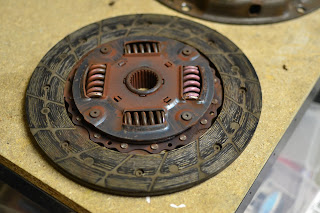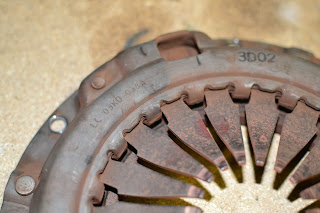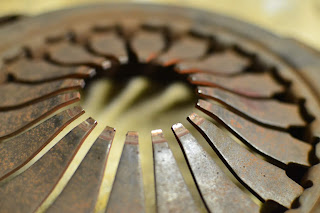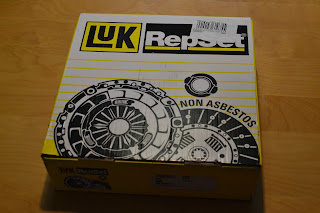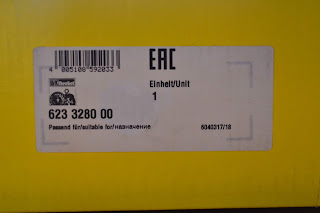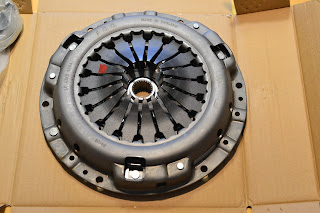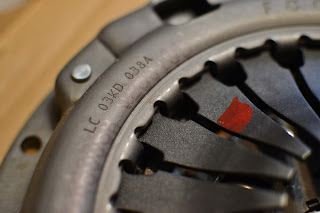à 227 000 km à peine passés.
Ce qui a lâché ? En fait, rien précisément...
Ça a commencé 1000 km avant avec des vitesses qui commençaient à accrocher.
Pas de craquement. Mais des "points durs" dans le levier de vitesses au moment d'enclencher les vitesses.
Je suspectais une fuite interne dans un des maitres cylindres de la commande de débrayage. Occasionnant un possible mauvais débrayage.
L’émetteur ayant 141 000 km et le récepteur étant d'origine...
Je les ai donc changé.
Finalement, je me suis retrouvé "en rade", 20 km après les avoir changé.
Impossible de passer une vitesse.
Après démontage de la boite de vitesse, constat : butée d'embrayage bloquée. Par la poussière abrasive du disque d'embrayage colmatée sur l'arbre de boite de vitesses...
Le disque a encore presque environ 5/10ème de mm de garniture avant les rivets.
Et le mécanisme est un peu usé au niveau de la butée.
La butée semble tourner à sec. La graisse ayant fini par disparaitre.
A 600€ l'embrayage complet chez Honda et n'ayant pas pour objectif de refaire 200 000 km avec la voiture, j'ai remis un LUK® référence 623 3280 00. A moins de 200€.
Pourquoi un LUK® ? Par ce que c'est une des marques "traditionnelles" fabricantes d'embrayages. Aujourd'hui faisant partie du groupe Schaffer. Fabricant de composants pour l'industrie. Notamment de roulements de la marque INA®. Gage de sérieux pour moi.
Par sécurité, j'ai remplacé la fourchette, sa rotule et son ressort de montage.
Les joints spi de sortie de boite pour les cardans aussi. Et l'huile MTF 3 aussi bien évidement.
Avant de le (faire) monter, j'ai pris l'embrayage LUK® en photo pour pouvoir le comparer à l'embrayage d'origine.
- Premier constat, le mécanisme (diaphragme), est le même !
De marque AP®, fabriqué en Angleterre et de référence LC 03KD 038A.
-Le disque est légèrement différent. La partie centrale de l'origine semble beaucoup plus technique, plus complexe que le LUK®. La différence sur le long terme.... je n'en ai aucune idée.
La garniture semble similaire.
- Pour la butée, la douille centrale du LUK® est en PEEK chargé verre (que l'on pourrait appeler plus grossièrement "plastique renforcé"). Alors que la butée d'origine est totalement en acier.
L'avantage du PEEK chargé verre est de garantir un bon coefficient de frottement et une bonne résistance à l'usure. A voir si l'assemblage acier/peek se révèle fiable sur le long terme.
Quelques photos des pièces usagées et des neuves avant montage.
That's it, I sank the clutch of the break! 227 000 km just past. What dropped? In fact, nothing precisely ... It started 1000 km before with speeds that were starting to hang. No crackling. But "hard points" in the shifter when switching on the gears. I suspected an internal leak in one of the master cylinders of the clutch control. Causing a possible bad walkout. The transmitter having 141 000 km and the receiver being of origin ... So I changed them. Finally, I found myself "in harbor", 20 km after changing them. Can not pass a speed. After disassembling the gearbox, note: clutch bearing was blocked. By the abrasive dust of the clutch disc clogged on the gearbox shaft ... The disc still has almost 5 / 10th of a mm of trim before the rivets. And the mechanism is a bit worn at the stop. The stopper seems to run dry. The grease has finally disappeared. At 600 € the complete Honda's clutch and not aiming to remake 200,000 km with the car, I gave a LUK® reference 623 3280 00. Less than 200 €. Why a LUK®? Because it is one of the "traditional" manufacturers of clutches. Today is part of the Schaffer group. Manufacturer of components for the industry. Including bearings of the brand INA®. Pledge of seriousness for me. For safety, I replaced the fork, its ball joint and its mounting spring. The spinnaker seals for the cardans too. And the MTF 3 oil, of course. Before putting it on, I took photos of the LUK® clutch to be able to compare it to the original clutch. - First observation, the mechanism (diaphragm), is the same! Brand AP®, made in England and reference LC 03KD 038A. -The disc is slightly different. The central part of the origin seems much more technical, more complex than the LUK®. The difference in the long term .... I have no idea. The filling seems similar. - For the bearing, the LUK® center bush is made of PEEK loaded glass (which could be called more roughly "reinforced plastic"). While the original stop is totally steel. The advantage of PEEK loaded glass is to guarantee a good coefficient of friction and a good resistance to wear. To see if the steel / peek assembly is reliable in the long term. Some pictures of used parts and new before assembly.
